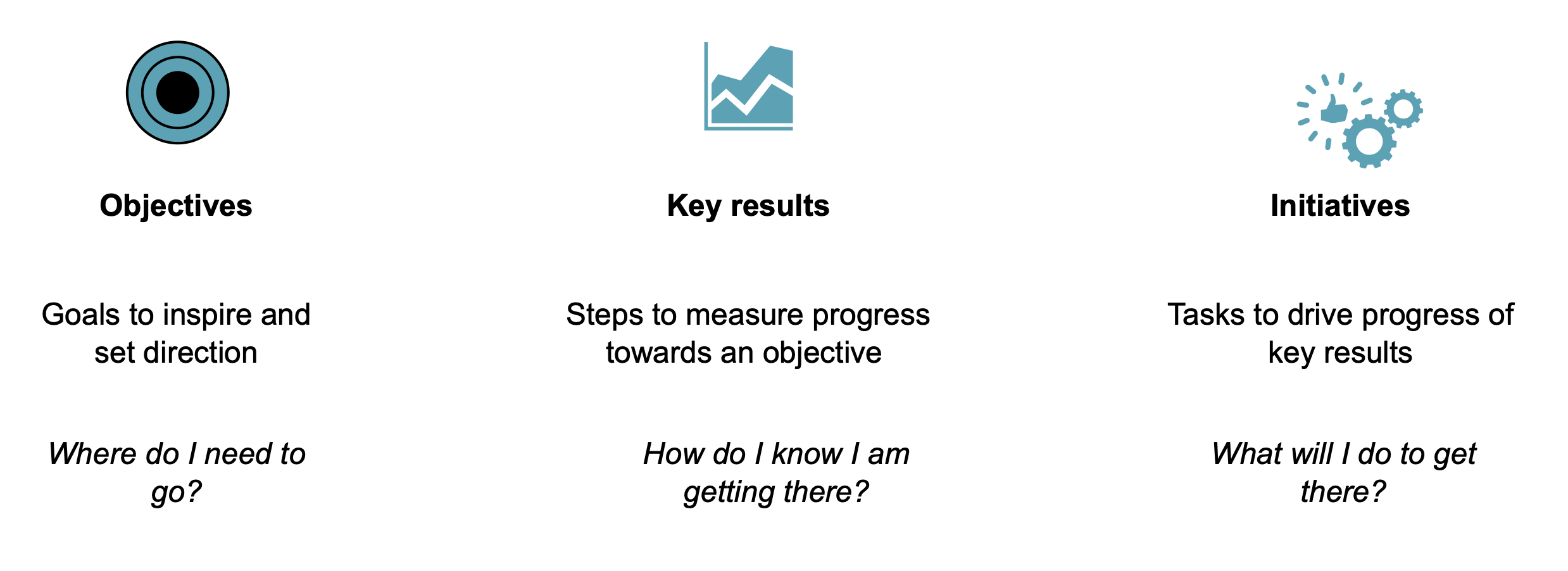OKR framework
Introduction
Objectives and Key Results (OKR) is a strategic goal-setting framework used by organizations to set challenging, ambitious goals with measurable results. The framework helps teams and individuals to align and focus their efforts on achieving significant impacts.
The concept of OKRs consists of the following main components:
-
Objectives - These are clearly defined goals which are qualitative, inspirational, and actionable. Objectives are designed to be motivating and provide a clear direction. They answer the question of what is to be achieved, focusing on the desired end result.
-
Key Results - These are a set of metrics that measure progress towards the objective. They are quantitative and should be easy to grade with a number. Key Results effectively track how the objective will be achieved. They provide milestones that act as a roadmap to reaching the objective.
-
Initiatives - This component refers to the specific actions, projects, or activities undertaken to influence the Key Results. Initiatives are what the team will do to drive progress toward the Key Results and ultimately achieve the Objective. They are the practical steps or efforts, providing a clear link between day-to-day operations and the strategic goals of the organization.

Developing effective OKRs
Developing effective Objectives and Key Results (OKRs) is crucial for the successful implementation of this goal-setting framework. The process involves setting clear, actionable objectives, determining measurable key results, and ensuring that these are aligned with the overall goals and vision of the organization. Below are detailed guidelines for each of these aspects:
Setting objectives
-
Clarity: Objectives should be clearly defined and easily understandable. Avoid technical jargon and make the objectives straightforward.
-
Inspirational and Motivational: The objectives should inspire and motivate the team. They should be challenging yet achievable, fostering enthusiasm and commitment.
-
Relevance: Ensure that the objectives are relevant to both the organization's mission and the team's role within the organization.
-
Actionable: Each objective should imply a clear course of action, providing a direction rather than just a statement of desire.
-
Time-Bound: While some objectives are ongoing, having a specific time frame can create a sense of urgency and focus.
Determining key results
-
Measurable and Quantifiable: Key results should be quantifiable. Use numerical values, percentages, or other clear metrics that can be easily tracked.
-
Realistic Yet Challenging: Set key results that are ambitious to push the team's limits but still within the realm of possibility.
-
Specific and Unambiguous: Avoid vague language. Be specific about what constitutes success for each key result.
-
Directly Linked to Objectives: Each key result should be directly contributing to the corresponding objective.
-
Regularly Reviewed and Updated: Key results should be dynamic. They should be reviewed regularly and updated if necessary to reflect changing circumstances or insights gained.
Aligning OKRs with organizational goals
-
Strategic Alignment: OKRs should be crafted in a way that they directly support the strategic goals and vision of the organization.
-
Departmental and Team Integration: Align OKRs not just at the organizational level but also ensure they make sense for various departments and teams.
-
Consistency Across the Organization: While OKRs may vary between teams, they should all fit into the broader organizational strategy and complement each other.
-
Communication and Transparency: Clearly communicate how individual OKRs contribute to the organization's goals. Transparency ensures everyone understands the bigger picture.
-
Flexibility for Adaptation: Be prepared to adapt OKRs in response to changes in the organization's strategy or external environment.
Implementation Strategies
Implementing OKRs effectively is key to leveraging their full potential in strategic planning and goal setting. This involves understanding the OKR cycle, roles of different organizational levels, and best practices for successful implementation. Here's a detailed breakdown:
OKRs cycle
-
Planning Stage: This initial phase involves setting objectives and key results. It's a time for brainstorming, assessing organizational needs, and defining clear goals.
-
Execution Stage: This phase is about putting plans into action. Initiatives are undertaken to meet the key results, and progress is continuously monitored.
-
Review Stage: Periodically, usually quarterly or semi-annually, the progress towards key results is reviewed. This includes evaluating what's working and what isn't.
-
Revision Stage: Based on the review, OKRs may need adjustments. This stage involves revising objectives or key results to align better with the organization's direction or to account for any changes in circumstances.
Role of leadership and teams
-
Leadership's Role: Leaders are responsible for setting the overall vision and ensuring that OKRs align with the organizational strategy. They also play a crucial role in motivating and guiding teams.
-
Team's Role: Teams are tasked with executing the initiatives that drive the key results. Their involvement in the OKR process includes planning, execution, and providing feedback.
Communication and transparency
-
Open Communication: Maintaining a culture of open communication where objectives and progress are transparently shared across the organization.
-
Transparency Throughout the Cycle: Ensuring transparency at every stage of the OKR cycle fosters alignment and a shared sense of purpose.
Best practices in OKR implementation
-
Realistic and Challenging Goals: Striking a balance between setting realistic objectives that are attainable and challenging enough to drive growth.
-
Regular Monitoring and Review: Setting up a system for continuous tracking of progress and periodic reviews to assess the effectiveness of OKRs.
-
Integrating Feedback: Creating channels for feedback from all levels within the organization to refine and improve the OKR process.
Common pitfalls and how to avoid them
-
Avoiding Overambitious OKRs: Setting objectives that are challenging but still achievable to prevent demotivation.
-
Preventing Misalignment: Ensuring that OKRs align with the broader organizational strategy to prevent working in isolated silos.
-
Distinguishing OKRs from Tasks: Clearly differentiating between strategic OKRs and day-to-day tasks to avoid confusion and maintain focus on long-term goals.